Background
"A Communication to my Friends" was written at a period which was turbulent even in the context of Wagner's very eventful life. Having been forced to flee Dresden, where he had been Kapellmeister at the Opera House, following his involvement with the May Uprising of 1849, he lived in exile, based in Zürich. He had no regular income and, although he had completed the score of his opera Lohengrin , he had at first little prospect of getting it performed, or of furthering his career as a composer. During the period 1849–51 he in fact wrote hardly any music, instead concentrating on writing a series of essays in which he expounded his ideas about music and the future of opera. These included "Art and Revolution" (written in Paris in 1849), "The Artwork of the Future" (1849), "Jewishness in Music" (1850) and the book-length "Opera and Drama" (1851).
Franz Liszt however offered to premiere Lohengrin in Weimar, where he was Kapellmeister to the court, and the production took place there in 1850. In the wake of this it was proposed to publish the librettos of Wagner's three most recent operas, (all of which had been written, as was normal with Wagner, by the composer himself); Der fliegende Holländer , Tannhäuser , and Lohengrin.
However, Wagner was very conscious that his concept of opera had significantly moved on since writing these works, to the extent that they hardly met – and in some aspects fell a long way short of – the standards and principles he had set out in "Opera and Drama". This provoked comment amongst both Wagner's admirers and his critics. Conscious of this, he therefore wrote "A Communication to my Friends" intending it as a preface to the librettos, explaining the evolution of his ideas and the reason for these discrepancies. [1] 'I was burning to write Something that should take the message of my tortured brain, and speak it in a fashion to be understood by present life'. [2] Wagner wrote to his friend Theodor Uhlig of the essay 'This is a decisive work!' [3]
Contents
Wagner's critique of the arts
The essay begins with an analysis of contemporary art-tastes, which Wagner castigates. Due to the materialism of the public 'only such artists can work in harmony with the present public taste as either imitate the monuments of the past, or stamp themselves as servants of the mode [fashion]; but both are, in very truth, no artists at all'. [4] Art is only to be drawn from 'life itself', and the only one of the arts which can meet his criteria for 'the warm-appealing Art-work' is drama. [5] Wagner proceeds to condemn the majority of modern artists, in painting and in music, as 'feminine [...] the world of art close fenced from Life, in which Art plays with herself.' Where however the impressions of Life produce an overwhelming 'poetic force', we find the 'masculine, the generative path of Art'. [6]
Wagner's artistic development
The remainder of the essay traces the writer's artistic development hand-in-glove with his life story, confirming Wagner's identification of himself as one who wrings Art from Life, i.e. 'masculine', rather than a 'feminine' artistic freeloader. Admitting that with the early Rienzi 'I had it mind only to write an "opera" ', with Der fliegende Holländer 'I became, myself, the artistic modeller of a 'stuff' that lay before me only in the blunt and simple outlines of Folk-Saga' [7] Gradually, working to the forms of myth as he perceived them, in subsequent operas, Wagner begins to remodel the idea of opera.
'I by no means set out to destroy [..] the prevailing operatic forms of aria, duet, &c.; but the omission of these forms followed from the very nature of the Stuff, with whose intelligible presentment to the Feeling [...] I had alone to do.' [8]
Wagner unfortunately found that his audiences were not willing to follow where he led them:
The public, by their enthusiastic reception of Rienzi and their cooler welcome of the Flying Dutchman, had plainly shown me what I must set before them if I sought to please. I completely undeceived their expectations; they left the theatre, after the first performance of Tannhaüser, [1845] in a confused and discontented mood. - The feeling of utter loneliness in which I now found myself, quite unmanned me.[...] My Tannhaüser had appealed to a handful of intimate friends alone. [9]
Wagner's plans for the future
Wagner refers to some of his projects, including a drama Jesus of Nazareth (the draft for which was published after his death), [10] and his libretto Siegfried's Death [11] (which was eventually to evolve into the Ring cycle). He explains how he intends to apply his new techniques of opera to this libretto. [12] After relating his disastrous visit to Paris in 1849, [13] he gives credit to his 'wondrous friend', Franz Liszt, for standing by him and undertaking to stage Lohengrin. [14]
Finally Wagner announces:
I shall never write an Opera more. As I have no wish to invent an arbitrary title for my works, I will call them Dramas [...]
I propose to produce my myth in three complete dramas, preceded by a lengthy Prelude (Vorspiel). [...]
At a specially-appointed Festival, I propose, some future time, to produce those three Dramas with their Prelude, in the course of three days and a fore-evening. The object of this production I shall consider thoroughly attained, if I and my artistic comrades, the actual performers, shall within these four evenings succeed in artistically conveying my purpose to the true Emotional (not the Critical) Understanding of spectators who shall have gathered together expressly to learn it. [...] [15]
This is his first public announcement of the form of what would become the Ring cycle.

Wilhelm Richard Wagner was a German composer, theatre director, polemicist, and conductor who is chiefly known for his operas. Unlike most opera composers, Wagner wrote both the libretto and the music for each of his stage works. Initially establishing his reputation as a composer of works in the romantic vein of Carl Maria von Weber and Giacomo Meyerbeer, Wagner revolutionised opera through his concept of the Gesamtkunstwerk, by which he sought to synthesise the poetic, visual, musical and dramatic arts, with music subsidiary to drama. He described this vision in a series of essays published between 1849 and 1852. Wagner realised these ideas most fully in the first half of the four-opera cycle Der Ring des Nibelungen.
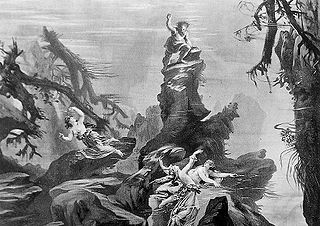
Der Ring des Nibelungen, WWV 86, is a cycle of four German-language epic music dramas composed by Richard Wagner. The works are based loosely on characters from Germanic heroic legend, namely Norse legendary sagas and the Nibelungenlied. The composer termed the cycle a "Bühnenfestspiel", structured in three days preceded by a Vorabend. It is often referred to as the Ring cycle, Wagner's Ring, or simply The Ring.

Der fliegende Holländer, WWV 63, is a German-language opera, with libretto and music by Richard Wagner. The central theme is redemption through love. Wagner conducted the premiere at the Königliches Hoftheater Dresden in 1843.

Lohengrin, WWV 75, is a Romantic opera in three acts composed and written by Richard Wagner, first performed in 1850. The story of the eponymous character is taken from medieval German romance, notably the Parzival of Wolfram von Eschenbach, and its sequel Lohengrin, itself inspired by the epic of Garin le Loherain. It is part of the Knight of the Swan legend.
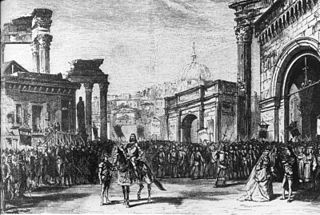
Rienzi, der letzte der Tribunen is an 1842 opera by Richard Wagner in five acts, with the libretto written by the composer after Edward Bulwer-Lytton's novel of the same name (1835). The title is commonly shortened to Rienzi. Written between July 1838 and November 1840, it was first performed at the Königliches Hoftheater Dresden, on 20 October 1842, and was the composer's first success.
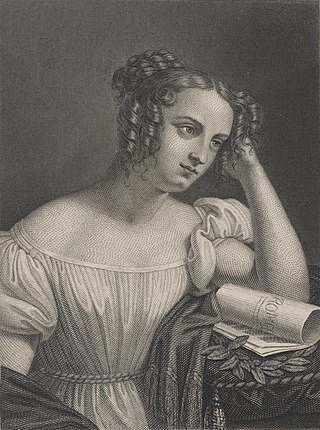
Wilhelmine Schröder-Devrient, was a German operatic soprano. As a singer, she combined a rare quality of tone with dramatic intensity of expression, which was as remarkable on the concert platform as in opera.

Tannhäuser is an 1845 opera in three acts, with music and text by Richard Wagner. It is based on two German legends: Tannhäuser, the mythologized medieval German Minnesänger and poet, and the tale of the Wartburg Song Contest. The story centres on the struggle between sacred and profane love, as well as redemption through love, a theme running through most of Wagner's work.

The evolution of Richard Wagner's epic operatic tetralogy Der Ring des Nibelungen was a long and tortuous process, and the precise sequence of events which led the composer to embark upon such a vast undertaking is still unclear. The composition of the text took place between 1848 and 1853, when all four libretti were privately printed - however, the closing scene of the final opera, Götterdämmerung, was revised a number of times between 1856 and 1872. The names of the last two Ring operas, Siegfried and Götterdämmerung, were probably not definitively settled until 1856.
Dunja Vejzović is an operatic mezzo-soprano and soprano from Croatia.
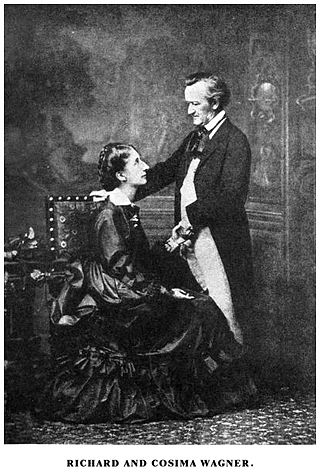
The Bayreuth canon consists of those operas by the German composer Richard Wagner (1813–1883) that have been performed at the Bayreuth Festival. The festival, which is dedicated to the staging of these works, was founded by Wagner in 1876 in the Bavarian town of Bayreuth, and has continued under the directorship of his family since his death. Although it was not originally held annually, it has taken place in July and August every year since the 75th anniversary season in 1951. Its venue is the Bayreuth Festspielhaus, which was built for the first festival. Attendance at the festival is often thought of as a pilgrimage made by Wagner aficionados.
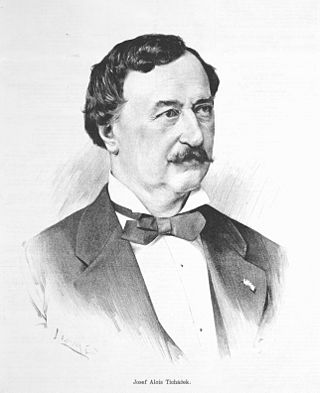
Josef AloysTichatschek, originally Ticháček, was a Bohemian opera singer highly regarded by Richard Wagner. He created the title roles in Wagner's operas Rienzi and Tannhäuser.
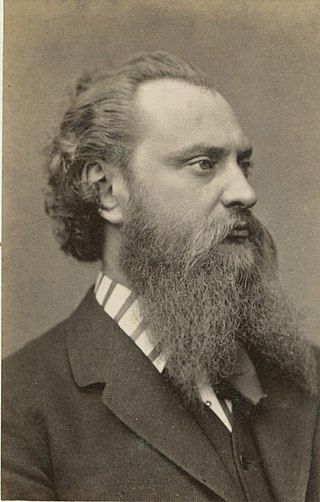
Albert Wilhelm Karl Niemann was a leading German operatic heldentenor especially associated with the operas of Richard Wagner. He gave important premieres in France, Germany, England and the United States, and played Siegmund in the first complete production of Der Ring des Nibelungen.

The Forest Opera is an open-air amphitheatre located in Sopot, Poland, with a capacity of 5047 seats, the orchestra pit can contain up to 110 musicians.

"The Artwork of the Future" is a long essay written by Richard Wagner, first published in 1849 in Leipzig, in which he sets out some of his ideals on the topics of art in general and music drama in particular.
"Music of the Future" is the title of an essay by Richard Wagner, first published in French translation in 1860 as "La musique de l'avenir" and published in the original German in 1861. It was intended to introduce the librettos of Wagner's operas to a French audience at the time when he was hoping to launch in Paris a production of Tannhäuser, and sets out a number of his desiderata for true opera, including the need for 'endless melody'. Wagner deliberately put the title in quotation marks to distance himself from the term; Zukunftsmusik had already been adopted, both by Wagner's enemies, in the 1850s, often as a deliberate misunderstanding of the ideas set out in Wagner's 1849 essay, The Artwork of the Future, and by his supporters, notably Franz Liszt. Wagner's essay seeks to explain why the term is inadequate, or inappropriate, for his approach.

Charles-Louis-Étienne Nuitter was a French librettist, translator, writer and librarian born in Paris, France, on 24 April 1828. He died there on 23 February 1899 after suffering a stroke a few days before.

Theodor Uhlig was a German violin-player, composer and music critic. He was the illegitimate son of Frederick Augustus II of Saxony.
Gerd Brenneis was a German operatic tenor who had an active international career from the late 1950s through the 1990s. Known for his interpretations of the works of Richard Wagner, he worked as a principal artist at many of the world's great opera houses, including the Deutsche Oper Berlin, La Scala, the Metropolitan Opera, and the Vienna State Opera.

The Königliches Hoftheater in Dresden, Saxony, was a theatre for opera and drama in the royal seat of the Kingdom of Saxony from 1841 and 1869, designed by Gottfried Semper. It was the predecessor of today's Semperoper, and is therefore sometimes called Altes Hoftheater.















